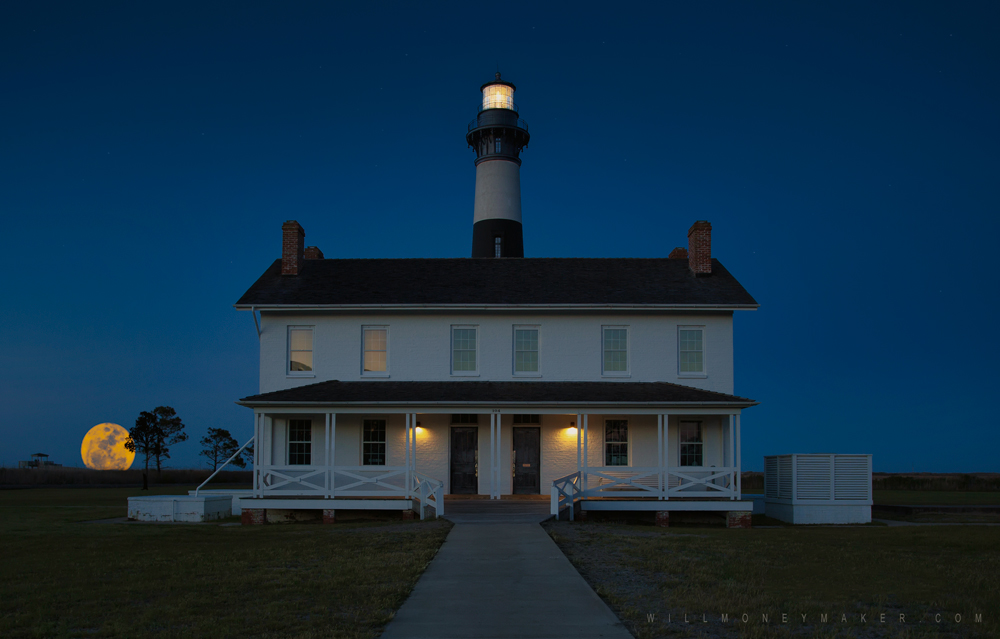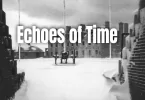The Bodie Island Lighthouse is a popular landmark attraction on the Outer Banks in North Carolina. The lighthouse is actually the third lighthouse that has stood on this location. The current lighthouse was built in 1872, is 156 feet tall, and is located on the first island in the Cape Hatteras National Seashore, on the Roanoke Sound side of the island.
From 2009 to 2013, the lighthouse underwent renovations, including being made climbable to the public. There are now 214 steps in the lighthouse that spiral around the interior of the building, leading visitors from the bottom of the lighthouse to the top of it. It is one of only a handful of brick tower lighthouses left in the United States, and one of an even fewer number that uses its original first-order Fresnel lens to shine its light.
There were two other Bodie Island lighthouses before this one. Both stood on Pea Island, south of the Oregon Inlet. The place where these lighthouses stood is currently underwater because of the southward migration of the inlet.
The first of the Bodie Island lighthouses was built in 1847 but abandoned in 1859 because it did not have a strong or reliable foundation. The second lighthouse was built the same year the first one was abandoned. This second lighthouse was deliberately destroyed by Confederate troops in 1861 as they retreated from the island. The reason for the destruction of the lighthouse was because the Confederate soldiers were concerned the lighthouse would be used as an observation post by Union soldiers.
After building and losing two lighthouses on Bodie Island, the third and current one was built in 1872. It was constructed a little bit north and farther inland of where the first two lighthouses were located. A fifteen-acre tract of land was secured on which to build the lighthouse.
The Bodie Island lighthouse underwent some upgrades over the years. It became partially automated in 1932, eliminating the need for someone to live in the lighthouse full-time to operate it. The same year it was partially automated, the light was upgraded to electric light, using generators that were powered by oil. In 1953, its ownership and care was transferred to the National Park Service. A person remained on-site at least part-time to ensure the lighthouse operated properly until 1940 when the lighthouse became fully automated. The oil-powered generators were disconnected in 1953 when it became part of the National Park Service, and its power was connected to the local commercial electrical grid.
The name of the island the lighthouse is located on is pronounced with a long “o” sound (as in “Bowdy”) by most people who are not from the Outer Banks. The Outer Banks locals, though, pronounce the island’s name as “body.” There is folklore associated with this that says the pronunciation is because of the astonishing number of dead sailors who would wash up on shore there from the shipwrecks that were common for several centuries in this area of the coastline. In fact, the area where Bodie Island sits is known by many seafaring people and maritime historians as the Graveyard of the Atlantic.
Despite this folklore of the island’s name, the true story is a bit different, if not quite as interesting. The island was originally called Bodie’s Island, a name given to it because a nearby barrier island was owned by the Bodie family prior to 1811. In 1811, the Roanoke Inlet, which separated the Bodie family’s barrier island from the Currituck Banks to the north, closed, and the barrier island was no longer a separate piece of land from what became Bodie Island.
Gift shops on the island sell maps of known shipwrecks on the floor of the ocean near the island. A stunning number of ships have been sunk there over the centuries, mostly to storms and shoals. During WWI and WWII, other ships were wrecked in that area due to German U-boats.
In an interesting bit of trivia, the Bodie Island lighthouse is featured in the background of the Federal Duck Stamp, which was issued from 1963 to 1964.
It was known for years that work needed to be done on the lighthouse. It took a while to raise funds to do it, and the work was postponed many times, but it finally began in August of 2009. The exterior work was finished in March of 2010, while the interior was half completed. The restoration work on the lighthouse was paused briefly in 2011 when significant issues with structural integrity on the new work was discovered in quite a few of the brand new support beams under the balcony. To fix these issues proved too costly to include in the original restoration project.
Also, Hurricane Irene went through the area in August of 2011, and took out some of the newly restored glass in the lantern room, and took off a protective covering for that same room, which caused some flooding in the lighthouse. The flooding caused the floors in the Light Station Double Keepers Quarters to buckle in places. Additional funding had to be obtained to fix these issues before the lighthouse could be opened to the public, as the National Park Service wished it to be.
Once the additional funding was obtained, the restoration work was continued in 2012, and completed in March of 2013. On April 18, 2013, there was a re-lighting ceremony at the Bodie Island lighthouse. The day after this ceremony was conducted, the Bodie Island lighthouse was finally opened to the general public to climb and explore, with only a small admission fee being charged for the pleasure.
Today, the Bodie Island lighthouse is an important historical landmark and attraction in the Outer Banks area of North Carolina. It is not only picturesque, but it gives visitors a fun activity to do while on the island and connects them to the history of the island at the same time.





